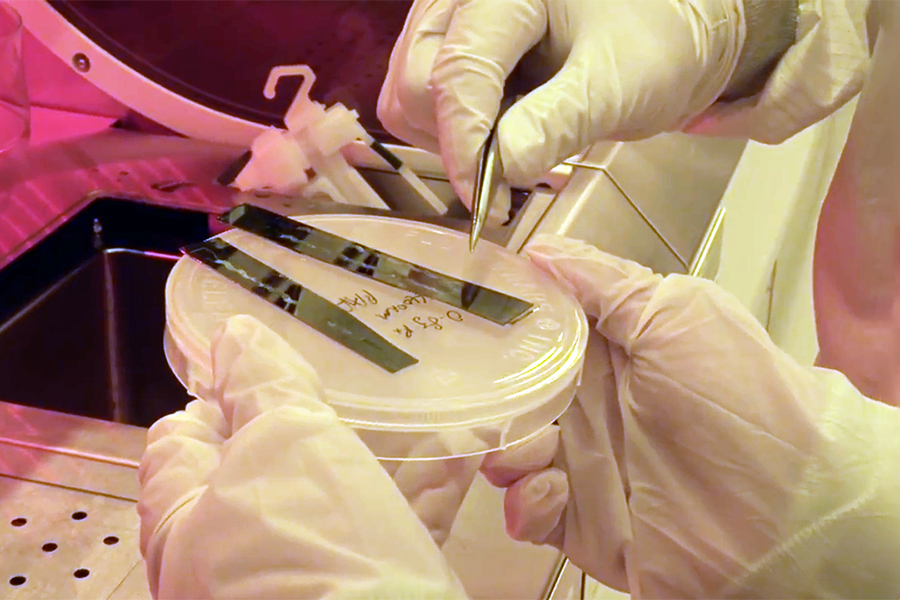
Engineering Advances in Medicine
New material improves brain-machine interfaces
Chris Bettinger and his group have created a hydrogel material and fabrication process for electrodes that stick to the brain, matching its soft, squishy makeup in order to keep the body from rejecting electronic probes that measure neural signals. These probes could lead to a deeper understanding of processes such as thoughts, emotions or motor control, and could improve treatments for arthritis and medical procedures to the heart, brain and spinal cord.
In the past 20 years, silicon-based electronics have evolved from being stiff like wood, to thin and flexible like paper, to stretchy and pliable like rubber bands. Bettinger's team is taking it one step further, making them not only flexible and stretchable but also extremely soft and adhesive. This could mean that the body would be less likely to attack a probe as an injury or a foreign object.
"If we could fabricate electronic devices that have mechanical properties closer to 'Jell-O' rather than wood or plastic, then we can surreptitiously interface neural probes with the brain in a more benign manner," said Bettinger, an associate professor of materials science and engineering and biomedical engineering.
The processes used to make sophisticated electronics require high temperatures (400 C or higher), a vacuum and exotic solvents, buffers, acids, and bases to etch materials and patterns. None of these are compatible with soft hydrogel materials.
Bettinger and his team created a new way to fabricate the electronics. First, they construct the electronic part on a substrate that is compatible with high temperatures, extreme solvents and a vacuum, and create the hydrogel substrate separately. Then, they remove the electronic piece from its original substrate and adhere it to the hydrogel substrate. The final device contains a thin layer of electronics on a soft, flexible and sticky substrate that has mechanical properties similar to those of the nervous system.
Chris Bettinger is working with his laboratory to develop brain-machine interfaces made of hydrogel-based electronics, which are less likely to cause brain injuries while stimulating or recording from the nervous system.
Another challenge was creating a material that was still adhesive in fluid. If the material can't adhere when wet, it would be like trying to keep a Band-Aid on while in the pool. The researchers studied the properties of animals like the blue mussel, which sticks to rocks underwater. They applied those same chemical principles when creating the hydrogel substrate.
"Instead of having to take a brain or a spinal cord and then stick something into it and then injure it," Bettinger said, "we can laminate it on top and avoid injury to the tissue."
The fact that the nodes do not injure the tissue and do not move around means they are able to record a stronger and more accurate signal from the firing neurons. The probes could now be used not only to record signals but also to stimulate therapies.
For example, the electrode array in the probe could block the signal that induces inflammation in people with rheumatoid arthritis. Instead of using painkillers like opiates, an electronic-based therapy that stimulates appropriate regions of the spinal cord could be more targeted and effective, while avoiding the risk of addiction when compared to pharmaceutical-based interventions. The electrodes can be used for long-term recording applications, such as testing how a new drug could affect the heart. A sticky, soft electrode that can bend and flex can ensconce the heart, record its contractions and indicate which drug might be most effective.
"We're trying to improve the temporal bandwidth of these probes, by preserving the longevity of the material. Then we can acquire more information and maintain a suitable signal-to-noise ratio," Bettinger said. "Researchers in multiple disciplines are trying to improve the way that electronic devices can interface with the nervous system. We feel that we are contributing to this broader effort by expanding the materials toolbox to improve device performance."
Bettinger and his group are collaborating with researchers in electrical and computer engineering at Carnegie Mellon and with researchers at the University of Pittsburgh. Their findings have been published in Advanced Functional Materials.